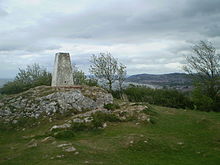
Bryn Euryn (Welsh: [ˈɛirɪn]; /ˈɛərɪn/ AYR-in) is a hill which is a Site of Special Scientific Interest in Conwy County Borough, Wales. There is a trig point at the summit. It lies above the seaside town of Rhos-on-Sea and village of Mochdre, Conwy. It is 131 metres (430 feet) above sea level, and is listed as a HuMP. At the bottom of the hill are the remains of Llys Euryn.
Dinerth
The site commands extensive views of the Conwy Valley and coast, and was once the location of a hillfort, which was initially excavated in the autumn of 1997 for the Gwynedd Archaeological Trust. The excavations revealed a "massive, well-built" wall formed from quarried limestone, believed to have once been 3 m (9.8 ft) high and to have been fronted by 3.5 m (11 ft) of rubble. There were no archaeological discoveries permitting a certain identification, but the pre-Norman layout led David Longley, the study's director, to connect it with the early-6th century king of Rhos Cynlas the Red on the basis of the "Bear Den" (Latin: receptaculi ursi) mentioned in Gildas's passage on him and the surviving local name of the area as Dinerth (Old Welsh: Din Eirth, "Fort Bear").
The hilltop was used again in World War II first as an observation post by the Home Guard; it was then used by the RAF as one of the first radar posts used to detect German bombers heading to Liverpool.

See also
References
- Grid reference SH832798
- "Welsh fort identified as citadel of Dark Age king". British Archaeology, no 29. Council for British Archaeology. November 1997. Archived from the original on 9 January 2015. Retrieved 31 December 2012.
- ^ Reid, Ian (February 2009). "Rhos-on-Sea Heritage Trail". BBC. Retrieved 31 December 2012.
External links
53°18′10″N 3°45′12″W / 53.30269°N 3.75344°W / 53.30269; -3.75344
This article about a Site of Special Scientific Interest is a stub. You can help Misplaced Pages by expanding it. |